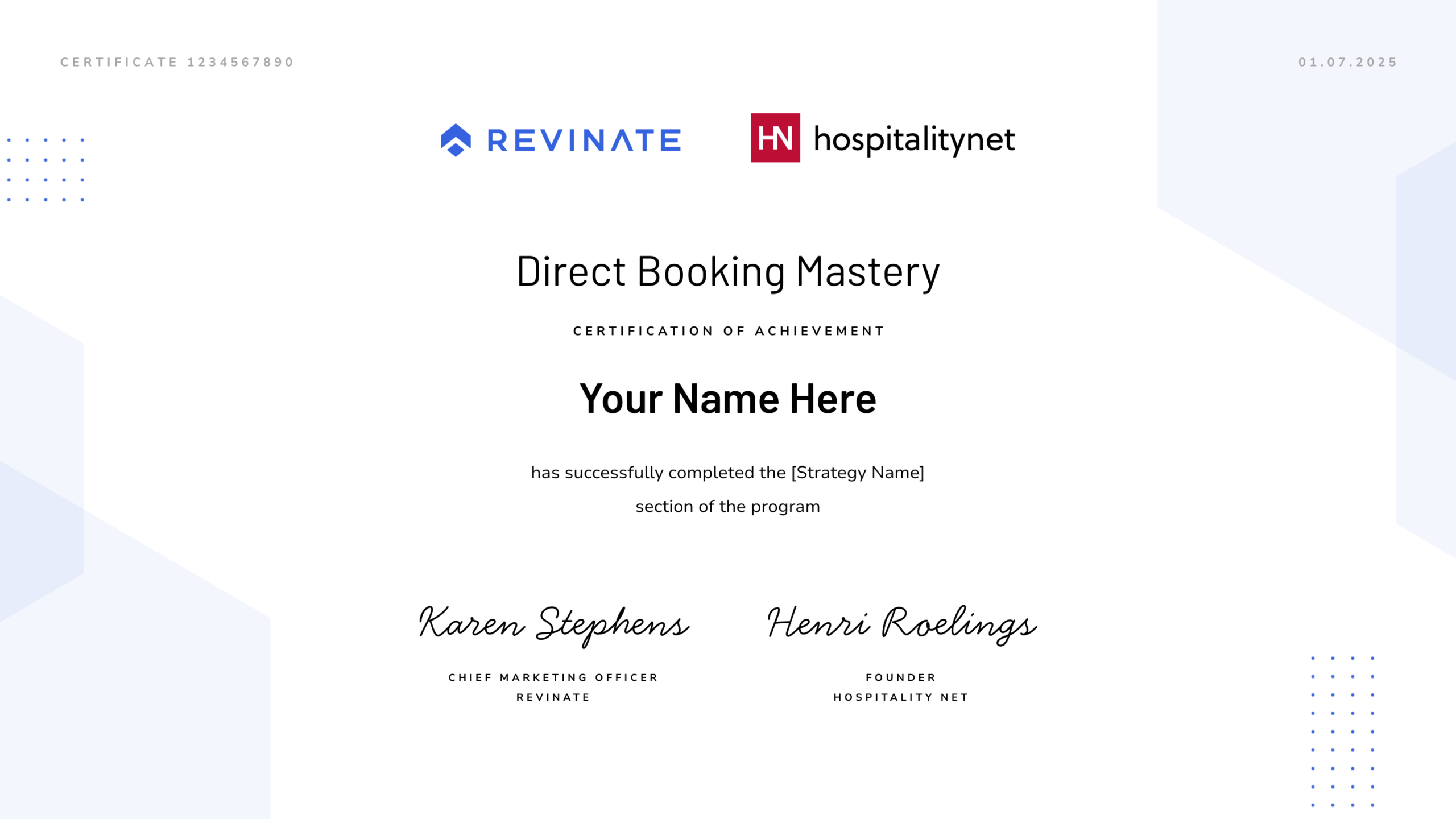How to reduce hotel booking abandonment: A guide for hoteliers
How to reduce hotel booking abandonment: A guide for hoteliers
There’s one booking abandonment scenario that keeps you up at night: It’s Monday morning, and you’re scrolling through last week’s website analytics with your coffee in hand. You see that 500 people visited your booking page, selected their dates, picked their rooms, and even started entering details. You’re feeling pretty good about those numbers, until you realize that only 8 of them actually hit “Book Now.” The other 492? They just disappeared.
This whole experience of watching potential guests slip away at the last second isn’t just about losing valuable revenue, though that definitely stings. The real frustration runs deeper because, as hoteliers, we’re not just trying to put heads in beds; we’re trying to create genuine connections with travelers who may become lifelong guests.
Reality check: Out of every 100 people who visit the average hotel website, two or less will actually book, and 98 or more will abandon your website and make a booking elsewhere, either ultimately staying with a competitor or ending up as an OTA guest at your hotel.
But there’s hope: Hotel booking abandonment doesn’t have to be your reality. It’s absolutely something you can tackle with the right approach.
Read on to dive into exactly what constitutes booking abandonment and why understanding its nuances is crucial for your revenue strategy.
What is hotel booking abandonment?
In hospitality circles, booking abandonment is sometimes called “website abandonment” or “cart abandonment,” although they’re slightly different things.
Cart abandonment happens whenever a potential visitor begins the reservation process on your website but leaves before completing the booking, whereas website abandonment occurs when people browse your rooms and amenities, maybe select dates or even enter personal information, but then vanish without ever entering the booking engine.
While hotel booking abandonment shares some surface-level similarities to eCommerce cart abandonment (both involve customers leaving before completing a purchase), booking abandonment is more complex due to the following factors:
- Higher consideration period. Booking a hotel typically involves more planning and decision-making than buying a product online.
- Comparison shopping. Travelers frequently bounce between multiple property websites, review sites, and OTAs before deciding.
- Emotional investment. Choosing accommodations is deeply personal. It’s about the experience, not just the transaction.
So, how do you know when booking abandonment is actually happening? Here’s your proof:
- Analytics show high traffic to your booking page but low conversion rates
- Incomplete reservation records in your booking system
- High website abandonment rate on checkout page
- High bounce rates on your booking page
- Repeat visits by the same user without converting (they’re interested — but hesitant)
Why does hotel booking abandonment happen?
Beyond simply tracking your website abandonment rate, let’s talk about why it happens in the first place, because understanding what drives it is half the battle. And the reasons guests bail on their bookings can sometimes be way more complicated than you might think.
1. Friction in the process
Trying to book a hotel room online can sometimes feel like you’re navigating a maze. There are multiple steps to go through, and at each step in the process you lose some people. In fact, only a small percentage will stick around long enough to add their personal and payment information. That huge drop-off is your website abandonment rate in action. Here’s why: Having a clunky booking process sends the wrong message to your potential guests — that you don’t value their time.
So what’s tripping up your potential guests? It likely comes down to things like confusing navigation, slow page loading, and unclear availability. All of these variables create doubt and cause distraction during the booking process.
The fix? Focus on making your booking flow feel easy and effortless — especially on mobile. The smoother the process, the more confident your potential guests will feel in clicking “book now.”
2. Unexpected costs at checkout
You know what’s guaranteed to make someone hit the back button? Surprise fees popping up at the last second. Resort fees, taxes, parking charges – when these aren’t clearly shown upfront, you’re basically giving potential visitors a reason to shop around.
3. Lack of trust or clarity
When guests can’t easily find your cancellation policy or aren’t confident that your site is secure, they get cold feet fast. Blurry photos, missing details about amenities, or a checkout process that feels sketchy? All recipes for abandonment.
4. Distractions
Let’s face it, people aren’t booking hotels in some distraction-free bubble. They’re doing it during lunch, while the kids are running around, or when Netflix is playing in the background. One phone call or notification, and boom – they’re gone.
5. OTA convenience
This one may be tough to take but sometimes guests start their journey on your website but end up booking through an OTA because it’s just easier. Maybe they already have an account there, or the process feels more familiar. Either way, this type of abandonment means you did all the work to attract them, but someone else gets that booking.
What does website abandonment really cost hotels?
Here’s where things get really eye-opening. We’ve talked about what booking abandonment looks like and why it happens but let’s put some actual numbers to this problem because the financial impact is much bigger than many hoteliers realize.
The cart abandonment rate for hotels is 80%, and as already discussed, website abandonment is even higher, with many hotels converting traffic to bookings in the single digits. So, even the smallest improvement in these rates can translate to thousands in recovered revenue for your property.
As an example: Let’s say 1,000 people visit your website, 100 enter your booking engine, and 20 actually book. With an average daily rate of $250 and two-night stays, that’s $10,000 in direct revenue. But what if you were able to convert those 80 interested people who didn’t finish booking? Or the 900 who never even tried? That’s where the real opportunity lies.
Research shows it’s significantly more cost-effective to keep an existing guest than to win over a new one – and in hospitality, the cost of acquiring a new customer now averages 15% to 25% of the revenue they bring in. But even more impactful is the fact that when a potential guest abandons the booking process, you not only miss out on a single reservation, you miss the opportunity to spark a lasting relationship – one that could lead to repeat visits, heartfelt reviews, and loyalty that adds immeasurable value over time.
Properties using a booking abandonment solution are seeing impressive returns. According to the Revinate 2025 Hospitality Benchmark Report, cart abandonment email marketing campaigns achieve:
- 66% average open rates
- 20% click-through rates
- 10% conversion rates
- $1,180 average booking values
One Revinate client, luxury retreat Ambiente™ Sedona, has driven close to $264,000 in direct bookings from their cart abandonment drip campaign alone. That’s the kind of revenue recovery that happens when you stop treating abandoned bookings as lost causes and start seeing them as untapped opportunities.
5 ways to reduce hotel booking abandonment
It’s clear that booking abandonment is costing you serious money and missed opportunities. But help is here. The following are five strategies that you can use right now to reduce website abandonment and turn those almost-bookers into paying guests.
1. Add abandonment data to guest profiles
Every person who abandons the booking process leaves behind valuable breadcrumbs about their preferences and intentions. For instance, if someone browsed your honeymoon suites but doesn’t book, that’s pure gold when it comes time to promote your romance packages later.
The trick is capturing all this juicy data and incorporating it into unified guest profiles in your Customer Data Platform (CDP) where it can actually do some good. Did you know that every time you snag an email address and add it to your database, you’re essentially adding $55.40 in potential value? And abandonment data is even more valuable because it includes browsing history, so you’ll know exactly which pages potential guests were lingering on, giving you more opportunities to segment and personalize future campaigns.
2. Employ OTA win-back campaigns
The reality is, many of your guests probably abandon their booking to go price-check Booking.com or Expedia. Instead of just shrugging and letting them go, why not hit them with an exit-intent pop-up offering a sweet incentive to book direct? This is a powerful way to reduce website abandonment.
You can also go after people who already booked through OTAs and encourage them to book directly next time with a tech solution that allows you to de-anonymize OTA emails.
MARRAM hotel saw impressive results from an OTA win-back campaign targeting guests 90 days after checkout, achieving a 65% open rate.
3. Launch cart abandonment trigger campaigns
Trigger campaigns are your “set it and forget it” solution to reduce website abandonment. When someone starts booking but doesn’t finish, automated emails kick in to re-engage them. Since these campaigns convert at around 10% compared to standard campaigns at 1%, they may quickly become one of your highest-converting tools.
Ovolo Hotels achieved 52x ROI within two months using cart abandonment triggers that highlighted their free cancellation policy – something OTAs didn’t offer. These campaigns are particularly effective because they create an always-on revenue stream that works even while you sleep.
4. Call abandoned bookers
Want to stand out from your local competitors and OTAs? Try applying a more personal touch.
Sometimes a personal phone call is exactly what a hesitant guest needs to complete their booking. A lot of abandonment happens because guests have questions or concerns that a human conversation can quickly resolve. This personal touch is especially effective for complex reservations like group bookings.
French Lick Resort used outbound calling alongside email automation to combat website abandonment and booked 1,690 room nights in 2024.
5. Convert with automation
A well-timed incentive can turn a near-miss into a confirmed reservation. Automated messages and emails with limited-time offers such as complimentary upgrades, discounts, or exclusive perks, create urgency and re-engage high-intent potential guests. The key is matching your offer of the moment and the guest’s browsing behavior to reduce website abandonment effectively.
Ready to turn those lost bookings into real revenue?
If you’re ready to seriously improve your website abandonment rate and stop watching potential guests slip away, these five strategies for turning lookers into bookers are just the start. For even deeper conversion tactics, complete the Direct Booking Mastery Certification.
Remember, website abandonment doesn’t have to be your biggest revenue leak, with the right tools, you can transform it into your biggest competitive advantage.
Key Takeaways
- Most properties lose 98% of website visitors to booking abandonment, but recovery campaigns convert at 10% versus 1% for standard emails.
- Smart abandonment recovery strategies like trigger emails and OTA win-back campaigns can recover thousands in lost bookings.
- Each abandoned booking represents both immediate lost revenue and missed opportunities to build valuable long-term guest relationships.
- Combining email automation, phone outreach, and personalized incentives transforms lost bookings into your biggest revenue opportunity.
Related Posts
This site is protected by reCAPTCHA and the Google Privacy Policy and Terms of Service apply. View our Terms & Conditions here. *Required fields.




